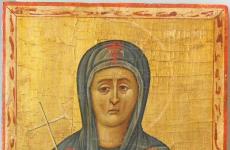С4-pathway of photosynthesis (hatch and slack cycle). Comparative characteristics of -C3 and -C4 plants Co2 acceptor in C4 plants is
Dark phase of photosynthesis
American scientist Melvin Calvin widely used the method of labeled atoms to study the dark reactions of photosynthesis associated with the fixation and conversion of carbon dioxide.
Substances bearing a radioactive label practically do not differ in chemical properties from ordinary ones. However, the presence of a radioactive atom makes it possible to trace the fate of the molecule, its transformations into other compounds, because the radiation emitted by the tag during the decay can be easily measured using instruments.
M. Kalvin's assumption was confirmed - carbon dioxide really joins a five-carbon sugar called ribulezodiphosphate (RDF). This is a reaction carboxylation which is catalyzed by an enzyme ribule diphosphate carboxylase... This enzyme makes up half of all the soluble proteins in chloroplasts and is probably the largest protein in the world. Its concentration in chloroplasts, equal to about 0.5 mM, is comparable to the concentrations of the substrates of the reaction it catalyzes.
Phosphoglyceric acid (FHA) is then converted to phosphoglycerol aldehyde(FGA) (fig. 10). At this stage, there is a need for the products of light reactions - ATF and NADP∙ N. In the dark, these energy-rich compounds are not formed in chloroplasts, and therefore phosphoglyceric acid does not convert into a three-carbon compound - phosphoglyceric aldehyde, which leads to a stop in the synthesis of organic substances. This stage of the Calvin cycle is called restorative.
Well, what is the further fate of phosphoglycerol aldehyde? Of the six molecules of this compound, as a result of cyclic transformations, three molecules of ribulezodiphosphate arise, which is necessary for the addition of new molecules of carbon dioxide. The cycle of these reactions is called the stage regeneration acceptor. The sixth PHA molecule leaves the Calvin cycle and, as the phosphoglycerol aldehyde molecules accumulate, various products arise from them: glucose in grapes, sucrose in sugar beet roots, starch in potato tubers, inulin in chicory rhizomes, and many others.
The work of M. Calvin on elucidating the essence of the dark reactions of photosynthesis is the greatest achievement of modern plant physiology. In 1961 he was awarded the Nobel Prize.
So, M. Calvin established that carbon dioxide is involved in a chain of reactions that are cyclic in nature: it joins ribulezodiphosphate, and at the end of the transformations, the same substance is again formed, ready for the addition of new carbon dioxide molecules. The aggregate dark photosynthesis reactions are called the Calvin cycle.
By studying green plants, scientists were convinced that in all cases the path of photosynthetic transformations is the same. It was only in 1966 that Australian scientists Hatch and Slack established that in some plants, in particular corn, these transformations proceed differently, with a deviation from Calvin's scheme. In corn, carbon dioxide does not attach to ribulezodiphosphate, but to a three-carbon compound - phosphoenolpyruvic acid , which leads to the formation of a four-carbon (C 4) compound - oxaloacetic acid ... After keeping plants in an atmosphere with labeled carbon dioxide, this substance is the first to be detected in chromatograms. For this reason, the path of photosynthetic transformations in corn is called 4-way... But the cycle of transformations according to Calvin was designated as C 3 -path, since the three-carbon compound of FHA - phosphoglyceric acid - is the first to be detected on the chromatograms.
So, CO 2, diffusing into the leaf through the stomata, enters the cytoplasm of the leaf mesophyll cells, where, with the participation of the enzyme phosphoenolpyruvate carboxylase reacts with phosphoenolpyruvate(FEP), forming oxaloacetic acid. The latter enters the chloroplasts, where it is reduced to malic acid ( malate ) due to NADP ∙ H, formed in the light phase of photosynthesis (Fig. 11).
Having formed in the cells of the leaf mesophyll, malate then moves to special cells surrounding the vessels. These are the so-called cells of the sheath of the vascular bundles (Fig. 12). They also have chloroplasts, only they are much larger than those in the mesophyll cells and often do not have granules. Here in the cells of the lining malate splits off carbon dioxide ( decarboxylated ), which is involved in the cycle of photosynthetic transformations already according to the familiar Calvin scheme. Along with carbon dioxide from malate formed phosphoenolpyruvate , which, having returned to the cells of the leaf mesophyll, can again attach carbon dioxide molecules.
In addition to corn, the C 4 pathway of photosynthesis has been found in some other cereals, mainly tropical and subtropical plants (sugar cane, sorghum, millet). Currently, 19 families of flowering plants are known in which there are C 4 -species.
Why would plants need to complicate the process of photosynthesis so much? After all, since each CO 2 molecule must bind twice, the energy consumption in C 4 photosynthesis is about twice as much as in C 3 photosynthesis. It turned out that the C 4 path has a number of advantages over the C 3 path. First, FEP carboxylase fixes CO 2 more efficiently than RDF carboxylase, and a large amount of CO 2 accumulates in the sheath cells of the vascular bundles. On the one hand, this creates better conditions for the operation of RDF carboxylase, and on the other hand, it suppresses photorespiration.
Photorespiration Is a light-dependent oxygen uptake and CO 2 evolution. It has nothing to do with normal respiration and occurs as a result of the fact that RDF carboxylase interacts not only with CO 2, but also with molecular oxygen. In this case, unnecessary glycolate is formed for further transformations of which energy is consumed and CO2 is released, which has already been utilized once in the process of photosynthesis. Photorespiration reduces the potential yield of C 3 plants by 30-40%. Therefore, the main advantage of C 4 photosynthesis is that the efficiency of CO 2 fixation increases significantly, and carbon is not lost uselessly as a result of photorespiration. Although C 4 plants consume more energy, such plants usually grow in conditions where light is very high. Therefore, they make more efficient use of the high light intensity and high temperatures of tropical regions. Secondly, C 4 plants tolerate drought better. To reduce the loss of water by transpiration, plants cover the stomata, and this leads to a decrease in the intake of CO 2. However, their carbon dioxide is fixed so quickly that it meets the needs of photosynthesis. And for each fixed CO 2 molecule, they consume half as much water as C 3 plants. It is not surprising, therefore, that many species of the arid tropical zone belong to C 4 plants. As soon as the sun rises, plants immediately begin to use carbon dioxide stored in organic acids for the synthesis of various substances. That is why they grow faster.
Studies have shown that in plants in which the process of photosynthesis proceeds along the C 4 pathway, there are two types of cells and chloroplasts:
1) small granal plastids in the cells of the leaf mesophyll;
2) large plastids, often devoid of granules, in the sheath cells surrounding the vascular bundles.
C4 plants include a number of cultivated plants of predominantly tropical and subtropical origin - corn, millet, sorghum, sugarcane and many malicious weeds - pigs, millet, chicken millet, humai, bristle grass, etc. As a rule, these are highly productive plants that steadily carry out photosynthesis at significant temperature rises and in arid conditions.
Features of photosynthesis:
The CO 2 acceptor is phosphoenolpyruvic acid PEP;
Photosynthesis is divided in space
The final products are: organic acids, FEP-carboxylase enzyme;
There is no photorespiration process;
The carboxylation process is carried out twice and this allows CO 2 to enter with the stomata closed.
A characteristic feature of C4-pathway plants is that the formation of products of the Calvin cycle occurs in chloroplasts located directly near the vascular bundles. This favors the outflow of assimilates and, as a consequence, increases the intensity of photosynthesis.
Stages of the C4 cycle:
1.carboxylation (occurs in mesophyll cells);
Phosphoenolpyruvic acid (PEP) undergoes carboxylation with the participation of PEP carboxylase and oxaloacetic acid (OAA) is formed, which is reduced to malic acid (malate) or aminated to form aspartic acid.
PIK, malate and aspartic acid are four-carbon compounds.

In the sheath cells, malic acid is decarboxylated by the enzyme malate dehydrogenase to pyruvic acid (pyruvate, PVA) and CO2. The decarboxylation reaction can vary in different plant groups using different enzymes. C0 2 enters the chloroplasts of the sheath cells and is included in the Calvin cycle and joins the RDF. Pyruvate returns to the mesophyll cells and turns into the primary acceptor of C0 2 - PEP. Thus, in the C4 pathway, the carboxylation reaction occurs twice. This allows the plant to build up carbon stores in its cells. C0 2 acceptors (FEP and RDF) regenerate, which creates the possibility of continuous functioning of the cycles. Fixation of C0 2 with the participation of PEP and the formation of malate or aspartate serves as a kind of pump for the supply of C0 2 to the chloroplasts of the sheath, functioning along the C3 pathway.
Path C4 got its name because in the dark phase, the primary product of CO2 fixation in this case is an organic compound not with three, but with four carbon atoms (oxaloacetic acid). This type of photosynthesis is possessed by tropical plants of hot countries, for example, bromeliads. It was noticed long ago that these plants absorb CO2 much better than the C3 plants. In the anatomical structure of leaves of C4 plants, along with normal common chloroplasts, around the vascular bundles they have a special kind of very dense chloroplasts, almost without thylakoids, but filled with starch. These chloroplasts were called lining.
In ordinary chloroplasts in C4 plants, as expected, the light phase of photosynthesis proceeds, and CO2 is fixed, but oxaloacetic acid is formed. Such oxaloacetic acid turns into malic acid, which enters the lining chloroplasts, where it is immediately decomposed with the release of CO2. And then everything goes like normal C3 plants. At the same time, the concentration of CO2 in the lining chloroplasts as a result becomes much higher than in C3 plants, and the very dense arrangement of these chloroplasts ensures that almost no oxygen is supplied to them, there are no intercellular spaces. Therefore, since there is no oxygen, and as much carbon dioxide as you want, photorespiration does not occur.
Thus, in C4 plants, CO2 fixation occurs more efficiently in the form of other compounds, and the formation of sugars is carried out in special chloroplasts, as a result of which the intensity of photorespiration and associated losses are reduced.
C4 plants can close their stomata in the heat without losing such precious moisture. They usually have enough CO2 in the form of malic acid.
27. Photorespiration: biochemical reactions, their localization. Physiological role of photorespiration.
Photorespiration Is a light-activated process of CO2 release and O2 absorption. The primary product of photorespiration is glycolic acid. Photorespiration is enhanced by low CO2 content and high O2 concentration in the air. Under these conditions, chloroplast ribulose disphate carboxylase catalyzes not the carboxylation of ribulose-1,5-diphosphate, but its cleavage into 3-phosphoglyceric and 2-phosphoglycolic acids. The latter is dephosphorylated to form glycolic acid.
Glycolic acid from the chloroplast passes into the peroxisome, where it is oxidized to glyoxylic acid. Glyoxylic acid is aminated to form glycine. Glycine is transported to the mitochondria, where serine is synthesized from two glycine molecules and CO2 is released.
Serine can enter the peroxisome and transfers the amino group to pyruvic acid with the formation of alanine, and itself is converted into hydroxypyruvic acid. The latter, with the participation of NADPH, is reduced to glyceric acid. It goes into chloroplasts, where it is included in the Calvin cycle.
In C4 plants-type carbon dioxide released during photorespiration reacts in mesophyll cells with phosphoenolpyruvic acid to form oxaloacetic and malic acids. Malic acid passes into the sheath cells, where it serves as a CO2 donor. Plants of the C3-path are characterized by a high intensity of photorespiration. Phosphoglycolic acid decomposes through a series of transformations with the release of CO2. Thus, during photorespiration, part of the intermediate products of photosynthesis is lost due to the release of CO2. Oxidation and carboxylation reactions compete with each other, and the implementation of the carboxylase or oxygenase function depends on the content of 02 and CO2
Photorespiration reduces the efficiency of photosynthesis, leads to the loss of assimilated carbon, but has some synthetic significance. In the early stages of life, when there was little oxygen in the atmosphere, rubisco took a key position in photosynthesis, and its oxygenase function did not cause problems. As the oxygen content increased, photorespiration losses increased, and a number of plants developed mechanisms for the active delivery of Rubisco carbon dioxide to the workplace (see C4 and CAM photosynthesis), which increased the proportion of its carboxylase activity to 100%.
The Calvin cycle is the main, but not the only way to reduce CO 2. So the Australian scientists M. Hatch and K. Slack (1966) and the Soviet scientist Yu. Karpilov (1960) found that in some plants, mainly tropical and subtropical, such as corn, sugarcane, sorghum and others, the bulk of the labeled carbon (14 CO 2), after a few seconds of photosynthesis, is found not in phosphoglyceric acid, but in oxalic-acetic (ABA), malic (YA) and aspartic (AA) acids. In these acids, up to 90% of the absorbed 14 CO 2 can be detected in the first seconds. After 5-10 minutes, the label appeared in phosphoglyceric acid, and then in phosphoglyceric sugars. Since these organic acids contain 4 carbon atoms each, such plants began to be called C 4 plants, in contrast to C 3 plants, in which the radiocarbon label appears, first of all, in FHA.
This discovery marked the beginning of a series of studies, as a result of which the chemistry of carbon conversion in photosynthesis in C 4 plants was studied in detail. The carbon dioxide scavenger in these plants is phosphoenolpyruvic acid (PEP) (Figure 2.19).
Rice. 2.19 С 4 - the path of photosynthesis
PEP is formed from pyruvic or 3-phosphoglyceric acid. As a result of β-carboxylation, PEP is converted into four-carbon oxaloacetic acid:
FEP + CO 2 + H 2 O → SHUK + F n
An enzyme that catalyzes the addition of CO 2 to PEP - phosphoenolpyruvate carboxylase - is now found in many monocotyledonous and dicotyledonous plants. The formed PIK with the participation of NADPH (the product of the light reaction of photosynthesis) is reduced to malic acid (malate):
PIKE + NADPH + H + → malate + NADP +
The reaction is catalyzed by NADP + -dependent malate dehydrogenase localized in chloroplasts of mesophyll cells.
In some plants, the formed ANA is converted into aspartic acid during reductive amination with the participation of aspartate aminotransferase. Subsequently, malic (or aspartic) acids are decarboxylated, and CO 2 and a three-carbon compound are formed. CO 2 is included in the Calvin cycle, joining ribulose-5-phosphate, and the three-carbon compound is used to regenerate phosphoenolpyruvate.
Currently, depending on which of the organic acids (malate or aspartate) is decarboxylated, C 4 plants are divided into two types: malate type (corn, cane) and aspartate type (sorghum, etc.) types.
In turn, plants of the latter type are subdivided into two groups: plants that use NAD-dependent malate dehydrogenase in the reaction and plants that use phosphoenolpyruvate carboxykinase.
As noted, C 4 plants differ from C 3 plants in terms of the anatomy of the leaf plate. Photosynthesis takes place in sheath cells and mesophyll cells. Both types of photosynthetic tissues differ in the structure of chloroplasts. Chloroplasts of mesophyll cells have a structure inherent in most plants: they contain two types of thylakoids - gran thylakoids and stromal thylakoids (granal chloroplasts). The sheath cells contain larger chloroplasts, often filled with starch grains and without granules, i.e., these chloroplasts contain only stromal thylakoids (agranal).
It is believed that agranal chloroplasts are formed during leaf ontogenesis from ordinary granal chloroplasts, since these chloroplasts also have granules in the early stages of development.
Thus, the following structural features are characteristic of C 4 plants:
- numerous air cavities, through which air from the atmosphere comes directly to a large number of photosynthetic cells, ensuring effective absorption of carbon dioxide;
- a layer of cells of the sheathing of vascular bundles, densely packed around the vascular bundles;
- mesophyll cells, which are located in less dense layers near the cells of the sheath of the vascular bundles;
- a large number of plasmodesmata between the cells of the sheath of the vascular bundles and the cells of the mesophyll;
The following path of photosynthesis is characteristic of the malate type of plants. Granal and agranal chloroplasts also differ in the nature of the photosynthetic reactions taking place in them. In mesophyll cells with small granal chloroplasts, PEP is carboxylated with the formation of PAA (primary carboxylation), and then malate is formed. Malat moves into the sheath cells. Here malate is oxidized and decarboxylated with the participation of malate dehydrogenase. CO 2 and pyruvate are formed. CO 2 is used for the carboxylation of ribulose-1,5-diphosphate (secondary carboxylation) and thus the C 3 -cycle is included, which occurs in the agranal chloroplasts of the sheath cells. Pyruvate returns to the mesophyll cells, where it is phosphorylated by ATP, which leads to the regeneration of PEP, and the cycle is closed (Fig. 2.20).

Rice. 2.20. Photosynthesis of C 4 -plants, which are used in decarboxylation reactions NADPH-dependent "apple enzyme" (malate dehydrogenase *)
Thus, in C 4 plants, carboxylation occurs two times: in mesophyll cells and in sheath cells.
What happens in plants in which aspartate (aspartic acid) is formed from PAK? In those plants that use NAD-dependent malate dehydrogenase for decarboxylation reactions, PAA is transaminated under the influence of cytoplasmic aspartaminotransferase, which uses glutamic acid amino group (HA-glutamic, OGK-2-oxoglutamic acid) as a donor.

Rice. 2.21. Photosynthesis of C 4 -plants, which are used in decarboxylation reactions NAD-dependent "apple enzyme" (malate dehydrogenase):
The formed AA passes from the cytoplasm of the mesophyll cells into the mitochondria of the cells of the sheath of the vascular bundle, probably through the plasmodesmata. There, the opposite reaction of transamination occurs, which leads to the formation of PACs. Then mitochondrial malate dehydrogenase restores the PAC to UC. YaK is decarboxylated by NAD-dependent malate dehydrogenase to form PVC and CO 2.
CO 2 diffuses from mitochondria into chloroplasts, where it is included in the Calvin cycle. PVC enters the cytoplasm, where it is transaminated by aminotransferase and converted into alanine (AL); the donor of the amino group is HA.
Alanine is transferred from the cytoplasm of the sheath cells to the cytoplasm of the mesophyll cells (probably through the plasmodesmata). Subsequently, it is converted to PVA (alanine aminotransferase); the acceptor of the amino group is OGA (oxaglutaric acid). Then PVA passes into mesophyll chloroplasts and transforms into PEP.
In C 4 plants using phosphoenolpyruvate carboxykinase in the decarboxylation reaction, the sequence of reactions resembles the previous ones. Only in this case, AAC is decarboxylated by phosphoenolpyruvate carboxykinase with the formation of CO 2 and PEP (Fig. 2.22).

Rice. 2.22. Photosynthesis of C 4 -plants using the enzyme phosphoenolpyruvate-carbxykinase in the decarboxylation reaction *
The intracellular localization of PEP carboxykinase and aspartate aminotransferase in this case is still unknown. The fate of FEP is also unknown; however, it is believed to be converted to PVC (these reactions are indicated by a question mark).
The CO 2 formed during the reaction is used as a substrate in the reactions of the Calvin cycle in the chloroplasts of the cells of the sheath of the vascular bundle. Alanine from the bundle sheath cells is converted to PEP in the cells of the leaf mesophyll; this occurs in the same sequence of reactions as in the previous cycles.
At the present time, it has been concluded that the main function of the C 4 -cycle, which occurs in the cells of the leaf mesophyll, is the concentration of CO 2 for the C 3 -cycle. C 4 -cycle is a kind of pump - "carbon dioxide pump". PEP-carboxylase found in mesophilic cells is very active. It can fix CO 2, including it in organic acids at lower CO 2 concentrations than does RDF carboxylase, and the activity of the latter in C 4 plants is low. Due to the functioning of this carbon dioxide pump in C 4 plants, the concentration of CO 2 in the sheath cells, where the Calvin cycle takes place, is several times higher than in the medium. This is very important, since C 4 plants live at elevated temperatures, when the solubility of CO 2 is much lower.
Cooperation between the two cycles is associated not only with CO 2 pumping. To restore FGK in the Calvin cycle, ATP and NADPH are needed. Agranal chloroplasts of sheath cells contain PS I, therefore only cyclic photophosphorylation occurs in them; this means that NADP + is not reduced in these cells. Granal chloroplasts of mesophilic cells contain both photosystems, they undergo cyclic and non-cyclic photophosphorylation with the formation of ATP and NADPH.
When malate formed in mesophilic cells enters the sheath cells, then during its decarboxylation, oxidation occurs and NADP + is reduced, which is necessary for the reduction of FHA.
Thus, the C 4 -cycle supplies the Calvin cycle with hydrogen for the reduction of CO 2.
Evolutionarily, the C 3 -cycle appeared earlier than the C 4; it is present in algae. Woody plants of the Hatch - Slek cycle are absent. This also confirms that this cycle arose later.
In conclusion, we note that the Calvin and Hetch - Sleck cycles do not act in isolation, but in a strictly coordinated manner. The relationship between these two cycles is called “cooperative” photosynthesis.
Most plants absorb inorganic carbon through the Calvin cycle. However, a rather large group of plants (about 500 species) of tropical origin developed in the process of evolution some modification of the process, assimilating inorganic carbon by the formation as a result of its acceptance of four-carbon connections. These are plants that have adapted to photosynthesis under conditions of high air temperature and excessive illumination, as well as low soil moisture (drought). Among cultivated plants, corn, millet, sorghum, and sugar cane have such a metabolic process. In a number of weeds, this particular feature of metabolism is also observed (swine, chicken millet, squid), etc.
A feature of the anatomical structure of such plants is the presence of photosynthetic cells of two types, which are located in the form of concentric circles - the cells of the parietal parenchyma and mesophyll, radially located around the vascular bundles. This type of anatomical structure is called the kranz-type (from the German Kranz-wreath).
This type of metabolism was studied in the 60s of the last century, with the studies of Soviet scientists Karpilov, Nezgovorova, Tarchevsky, as well as Australian scientists Hatch and Slack, playing a large role. It was they who proposed the complete cycle scheme; therefore, it is customary to call this process the Hatch-Slack-Karpilov cycle.
The process takes place in two stages: CO 2 entering the mesophyll enters into a compound with a three-carbon compound (PEP) - phosphoenolpyruvic acid - which turns into a four-carbon compound. This is the key point of the process, from which it got its name, since inorganic carbon, being accepted by a three-carbon compound, turns into a four-carbon compound. Depending on what kind of four-carbon compound the inorganic carbon turns into, three groups of plants are distinguished:
NADP-MDH form malic acid with the participation of the enzyme malate dehydrogenase, and then pyruvic acid,
NAD-MDH form aspartic acid and alanine,
PEP-KK form aspartic acid and phosphoenolpyruvic acid.
The most important plants for agriculture belong to the NADP-MDH type.
After the formation of a four-carbon compound, it moves into the inner cells of the parietal parenchyma and the cleavage or decarboxylation of this molecule. The separated carboxyl group in the form of COO enters the Calvin cycle, and the remaining three-carbon molecule, PEP, returns back to the mesophyll cells.
This way of fixing carbon dioxide allows plants to accumulate a stock of carbon in the form of organic acids, to carry out the process of photosynthesis in the hottest part of the day while reducing water losses for transpiration by closing the stomata. The efficiency of water use by such plants is twice that of plants originating from temperate latitudes.
For C 4 -plants are characterized by the absence of a reverse flow of carbon dioxide during photorespiration and an increased level of synthesis and accumulation of organic substances.






